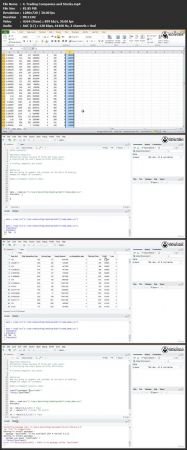Fraud Analytics in Banking and Credit using Machine Learning

Published: 8/2021
Duration: 2h 22m | Video: .MP4, 1280x720 30 fps | Audio: AAC, 44.1 kHz, 2ch | Size: 1.01 GB
Genre: eLearning | Language: English
Understand fraud detection analytics and the robust internal controls and risk management system in organizations
What you'll learn:
Learn about basic banking system concepts that are needed to resolve and understand what kind of frauds are taking place in the banking sectors every day
In this Fraud Analytics Training, firstly you will be introduced to fraud and its types which are very important to resolve any kind of fraud
Learn about some analytical subjects and concepts that are used to analyze and predict the data that are causing harm to the organizations or banks/individual
Learn about data science which is a high demanding subject today which has many different algorithms that are useful in predicting and detecting
Description:
In general, fraud can be defined as some illegal or criminal thing done by any person who intended to deceive in financial organizations or personal profit. So the processes of analyzing such illegitimate transactions done by anyone like buyer or customer are caught and only the legal transactions are allowed to be made. As fraud is increasing in day to day life so to analyze frauds that are occurring in the organizations or companies these frauds are analyzed using some quantitative science to understand the fraud, through BI (Business Intelligence), and then we have to develop effective fraud detection solutions through data science.
To carry on the fraud analytics we have to detect the frauds to find the proper solutions to overcome these illegal activities. Fraud detection is a process having different sub-processes to carry on, for detecting activities that take place to prevent money or credentials from being illegally known to another person. Machine learning is a scientific discipline that explores the construction and study of algorithms that can learn from data. Such algorithms operate by building a model from example inputs and using that to make predictions or decisions, rather than following strictly static program instructions. Machine learning is closely related to and often overlaps with computational statistics; a discipline that also specializes in prediction-making.
Through this training, we are going to guide you through the process of understanding the concept of fraud detection in credit payments using a case study. We have used Kmeans and hierarchical clustering for understanding the data and also used other visualization techniques and methods to compare and understand the flow of Data.
The main aim of this course is to provide a wide understanding of fraud detection analytics and students or professionals will also get to understand the robust internal controls and risk management system in organizations.
for detecting fraud machine learning concepts and algorithms are required to understand. In this section, we detect fraud in credit card payments or transactions using installation packages for fraud detecting. In this section, algorithms like Kmeans, hierarchical clustering for understanding the data. This section, includes topics on cust ranking that explains risk analysis, rank functions, RHS constraints, VRS, CRS efficiency, etc. You will first be introduced to the banking system which includes loan status grades, beta value, predict value, performance values, etc. In this section, you will also learn about logistic regression algorithms to implement them in a project.
Who this course is for:
To undergo this course, students, professionals, product managers, or any other who are interested in learning about fraud analytics can take up this Fraud Analytics Training. Even marketing professionals can also take up this course so that they can make their customers beware of frauds that are taking place. Marketing professionals or researchers also can take up this course so that they can upgrade their skills or can gain knowledge on new fraud that is there in today’s banking sectors.
